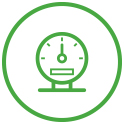Water use efficiency

Water use efficiency must be addressed in the context of other CWMS targets because some actions that improve water use efficiency can be detrimental to energy efficiency and biodiversity protection. The development of benchmarks is therefore part of the goals. There is a focus on irrigation water use, but goals for community water supplies and other uses are also included.
Here's how things are progressing against 2025 goals.
Best practice and benchmarking
By 2025: 90% of water users meeting or exceeding the agreed water use benchmarks.
Has this goal been met?
No agreed regional water use benchmarks have been set for Canterbury.
However, survey results from nine large Canterbury irrigation schemes show that audits of shareholders Farm Environment Plans are used as a benchmark to demonstrate achievement of high confidence levels in water use efficiency. Approaches vary between schemes on how shareholders are assisted to achieve this.
- Codes of Practice are updated regularly by Irrigation New Zealand.
- Central Plains Water Ltd. Annual Report 2024 (PDF file, 6.6MB) shows 99.3% Audit Grade A or B, which demonstrates compliance and achievement of GMP for water use.
Environment Canterbury will continue the Farm Environment Plans and audit programme, encouraging Good Management P<ractices for irrigation and water use.
By 2025: 100% of water used for irrigation and stockwater is operating according to water use Good Management Practices.
Has the goal been met?
There is insufficient data available to report progress on this goal.
However, in 2024 Environment Canterbury completed audits on a number of Farm Environment Plans which showed that over 80% of consent holders sampled are meeting expectations as per the Canterbury Land and Water Regional Plan Good Management Practices.
Data from Central Plains Annual Report 2024 (PDF file, 6.6MB) shows a 99.3% high audit grade for shareholders Farm Environment Plans, alongside other metrics.
Environment Canterbury will continue the Farm Environment Plans and audit programme, encouraging Good Management Practices for irrigation and water use.
By 2025: Continued updating of best practice as industry makes advances.
Has the goal been met?
Good Management Practices for irrigation water use has benefitted from industry codes of practice.
Irrigation New Zealand continues to update best practice information, including irrigation design and installation, performance testing, water application, performance testing and good management practice water use guidance as the industry makes advances.
In 2022, the New Zealand Fish Screen Working Group, a subgroup of the Canterbury Water Management Strategy, completed a fish screen design and installation project to improve guidance for effective fish screen design.
Irrigation New Zealand will continue to update best practice guidance and resources to align with current industry knowledge.
By 2025: Drinking water suppliers have demand management programmes in place as part of good infrastructure practices.
Has the goal been met?
A number of drinking water suppliers in Canterbury currently have demand management programmes in place, representing the drinking water supply for 85% of the region’s population.
Other drinking water suppliers in the region operate with partial or informal demand management programmes.
- Information about the Christchurch City Council demand management programme can be found in the Te Wai Ora o Tāne Integrated Water Strategy.
- Information about the Selwyn District Council demand management programme can be found in the Water Conservation and Demand Management Plan (PDF file, 299KB).
- Information about the Waimakariri District Council demand management programme can be found in the Water Conservation Strategy.
Water suppliers will continue to adopt demand management programmes as a part of good infrastructure practice.
By 2025: Policy mechanisms are in place to ensure that efficiency gains are returned to the environment where there is overallocation of the water resource.
Has the goal been met?
The Canterbury Land and Water Regional Plan (CLWRP), made operational in 2016, lists strategic policies to encourage the reduction of take where water is overallocated across Canterbury.
The latest version of the Canterbury Land and Water Regional Plan (CLWRP) details policies to ensure efficiency gains are returned to the environment where there is an overallocation of the water resource.
Central government reform of the Resource Management Act is underway. Future Environment Canterbury policy will be guided by this process.
